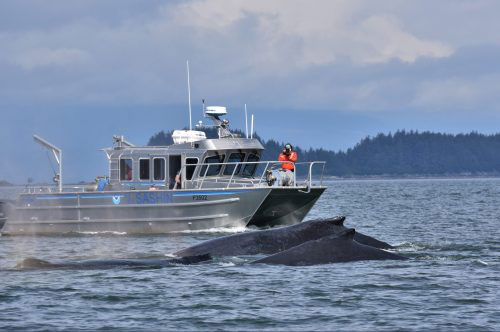
Canceled tour season allows study of undisturbed humpback whalesBy ALICE BAILEY
August 16, 2020
The data will establish a baseline of behavior and physiology to help determine how whale-watching tour vessels affect whales in more typical years. “When I learned back in March that the cruise ship season would be postponed or even suspended for the summer, I realized we had this incredible opportunity to study whales in the absence of high levels of vessel traffic,” said Heidi Pearson, the principal investigator of the study. Pearson is an associate professor of marine biology at the University of Alaska Southeast. She works on the project with colleagues at the University of Alaska Fairbanks, the National Oceanic and Atmospheric Administration’s Auke Bay Lab and the NOAA Alaska Regional Office.
The whale-watching industry in Juneau has tripled in the past two decades, raising concerns about potential impacts on humpback whales. Studies indicate that humpbacks tend to increase speed, change direction and breathe faster in the presence of vessels, which indicates that the whales may be taking measures to avoid them. Marine mammal scientists have studied humpback whales in Southeast Alaska for decades but never before in an environment so devoid of human activity. The lack of baseline data has made it especially challenging for NOAA Fisheries, the management agency for humpback whales, to evaluate impacts of tour vessels and support continued recovery of the species. “The goal of the project is to determine humpback whale presence, local abundance and residency patterns. We’ll examine the blubber biopsies and respiratory blow samples to measure steroid hormones associated with stress, like cortisol, corticosterone and aldosterone,” said Shannon Atkinson, a co-principal investigator for the study and professor at the UAF College of Fisheries and Ocean Sciences. Atkinson will lead the laboratory analysis, with an emphasis on hormones. “We’ll also analyze progesterone and testosterone to help identify sex and life-history status,” she said. Juneau is a premier location for whale watching, especially humpback whales. Humpbacks migrate to Alaska each spring to feed in the nutrient-rich waters and build up fat stores through the summer. Each fall, they migrate to Hawaii, Mexico and other areas of the Pacific Ocean to breed and calve in tropical waters over the winter. Scientists will compare data collected during summer 2020 with data collected previously by NOAA Fisheries, UAS and UAF during years of normal whale watching. They hope this will help managers decide whether whale-watching guidelines need changes to ensure a sustainable whale-watching industry. The project is funded by NOAA Fisheries Alaska Region, through a grant to the Pacific States Marine Fisheries Commission.
|
|||||
